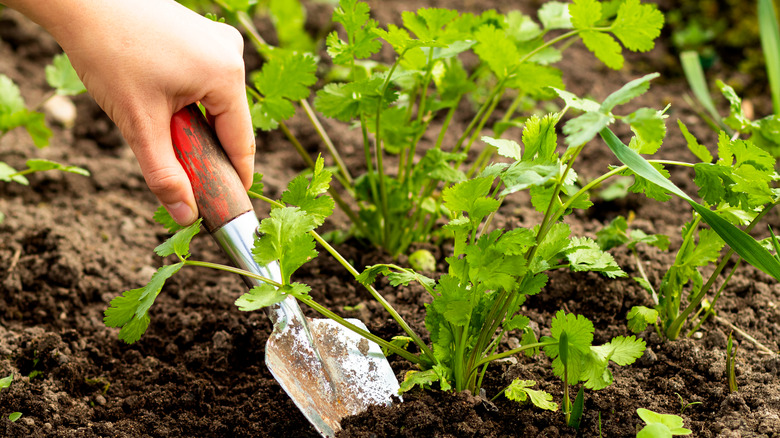Here's How To Prune Cilantro To Keep It Healthy And Happy
Across hundreds of cultures and cuisines, cilantro is an essential ingredient in many recipes. While some amateur chefs choose to purchase their cilantro bunch at the store, others grow it in their garden for an easy grab while cooking. If you happen to fall in the latter category, then you're likely familiar with the concept of pruning, aka selectively removing stems and leaves that don't benefit the plant. Although the process sounds contradictory, pruning helps plants grow healthy and fast. When it comes to culinary herbs, pruning is an essential act of love that can help you better grow and care for your cilantro plant. All it takes is identifying weak stems, trimming them, and continuing the process weekly.
You may have been told to prune your plants when it comes to flowers and shrubs, but the concept isn't always applied to culinary herbs. More often than not, herbs are extremely delicate compared to other plants, making the idea of refinement seem more harmful than beneficial. If you can achieve the process effectively, delicately, and sterilely, however, the benefits outweigh any potential harm — you'll have more time to harvest the leaves, prevent weak stems, and extend the life of this flora. We'll walk you through the process of pruning cilantro, mistakes to avoid, and tips on maintaining a garden filled with well-pruned cilantro.
How to properly prune cilantro
Since cilantro benefits from cooler temperatures, it's best to plant the herb in the fall or early spring to avoid home-grown cilantro that tastes bitter. Cilantro is susceptible to bolting, often caused by high temperatures that result in plants seeding too early, turning bitter, and becoming unusable. Instead, cooler temperatures will help the plant grow with ease. Once the plant has sprouted to approximately 6 inches tall, you're ready to prune. To start, use rubbing alcohol to sterilize your gardening shears before moving to the base of the plant. Identify any stems that may be damaged, yellowed, or dead as you work your way up to the cilantro leaves. If your cilantro has begun sprouting flowers, use this time to gently snip them from the base before disposing of them. Be careful not to overdo the pruning process in one sitting — instead, routinely prune cilantro once a week and cut no more than ⅓ of its weight at once.
Be sure to thoroughly rinse the plant and store leftover leaves in the freezer for up to one week (after that, cilantro begins to lose its flavor). If you plant, prune, and use cilantro at optimal times, you'll ideally have cilantro to last you through the summer until it's time for the pruning season again. Similarly, routinely harvesting cilantro leaves as they grow will keep the plant healthy as you slowly collect the fruit of your labor and watch your garden flourish.
